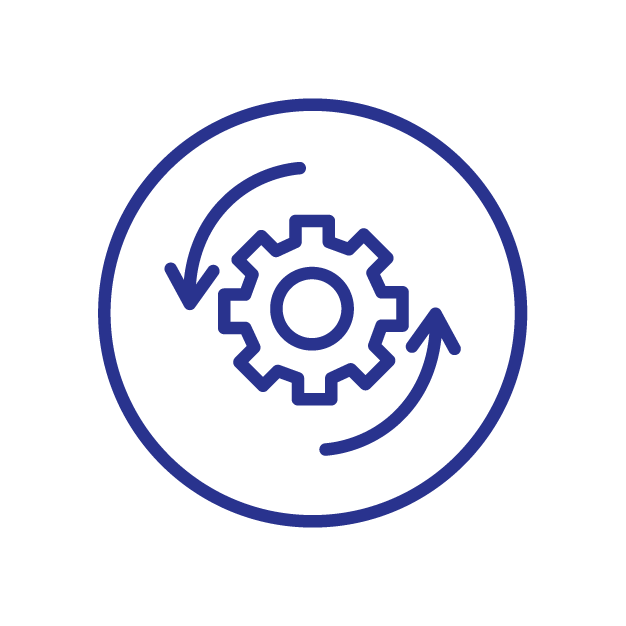Before you start the design process, it is important to set some guiding principles that will help you navigate the operation. Below you’ll find design principles, considerations and other things that you can keep in mind while you embark on this design journey.
Some principles to keep in mind while designing your new hybrid courthouse.
01. Always empathize with perspectives other than your own when designing.
There are many different people who come to use the courthouse, and it should serve everyone well! Whenever designing a new space or flow of interaction, pretend you are someone with no legal knowledge coming to the courthouse for the first time to see if it works and makes sense. Better yet, ask someone who is actually in this position how they experience your design if at all possible.
02. Accessibility is paramount.
In order for access to justice to be possible, access to the courthouse, in both it’s physical and virtual spaces needs to be possible for everyone.
03. Make the simplest moves possible.
Designing a hybrid courthouse does not, and should not, have to be complicated. Think about only what is essential for you to do to achieve your goals, and do that as simply as you can.
04. Don’t underestimate the psychological impact of design.
Participating in the legal system can be a very stressful, negative experience for many people. Do not underestimate the effect design can have on people’s physiological states of being, and thus their emotions, thoughts and reactions. Small gestures like adding plants, and implementing softer lighting and textures may seem like arbitrary aesthetic preference, but they are proven to improve states of well-being, thus enabling a better experience for all parties.
05. Embrace change and be adaptable.
The justice system is undergoing some pretty radical change whether we like it or not. What we understand about both design and the legal system will continue to evolve at a rapid pace, and you should be able to move along with it.
Considerations on changing a court house
At this point, you are likely aware of just how radically COVID-19 has changed how courthouses function. Historically, courthouses have been designed for judges and lawyers without much attention paid to how well they function for regular people who come to court. And sometimes they don’t work well for anybody! Rather than trying to return to this pre-pandemic status quo, the disruption caused by the pandemic has opened up great opportunities to critically consider how courthouses are or are not working, and from there, start imagining how to design hybrid courthouses of the future.
The Ups and Downs of Virtual Court
While virtual court has a high potential to increase access to justice for many people, there are also some negative aspects that warrant careful consideration. As you start to consider your new hybrid courthouse, you should keep these downsides in mind and consider how best to mitigate their effects through design.
| Upsides | Downsides |
| Preserved health and safety With virtual systems now in place, it is easier to adhere to new health and safety standards. | Increased security and privacy risks This is a concern, particularly in sensitive cases involving victims of domestic violence. Online court proceedings are often streamed on online platforms, such as YouTube. This allows an unprecedented number of people to watch and share personal details of the litigants online. Also, abusers can now more easily detect the whereabouts of the victim by observing the video background during Zoom proceedings. |
| Improved efficiency With virtual systems now in place, litigants no longer have to wait around the courthouse all day to be called for their hearing, resulting in improved efficiency and getting more people in an out of hearings expediently | Increased risk of bias Because litigants are no longer in the same physical setting, factors such as video quality, background visuals, background noise, and many others can influence a judge’s and jurry’s opinion of the litigant in ways that seeing them in person would not |
| Increased convenience Litigants can call in from a location of their choice, and no longer have to take a whole day off of work, arrange childcare, arrange transportation, or deal with other logistical barriers that could prevent them | Amplification of digital divide Many litigants do not have access to necessary technology or internet and/or do not know how to use necessary technology, putting them at a disadvantage during virtual hearings |
| Increased participation Because virtual hearings can be both more efficient and more convenient, many litigants are more likely to participate in the justice system | Risk of technological malfunctions An unstable connection, disconnected audio or video, and many other things can go wrong during a virtual hearing, preventing justice from being served |
Why Lawyers Should Care About Design
Design can greatly improve the the usability of your courthouse, thus improving peoples’ chances to successfully navigate through the justice system. Architectural design can be very broad in scope, but we’ll focus on particularly important concepts and terms that are outlined below.
Designing Courthouses = Designing Systems of Justice!

Accessibility Design (or lack thereof) can be the make-or-break factor when it comes to accessibility. If courts operate on the core tenet that everyone should have equal and equitable access to justice, this means that they need to consider how design can impede or facilitate access to the courthouse, and therefore the justice system, for people across a spectrum of physical, cognitive, linguistic, and other abilities.

Psychological + Emotional Impact The design of spaces that we occupy can influence our mental states even when we do not realize it. In a courthouse, people may be facing a whole range of negative emotions. Some small spatial and material modifications can help counter these emotions, leading to a better experience and interactions between all parties involved (legal professionals included).

Efficiency A well-designed, easily navigable and organized building can increase the efficiency with which legal work can be performed. If the building operates as smoothly as it can, this means that legal professionals can spend more time doing their work rather than contending with poor building design and people can get in and out of the courthouse more expediently.

Security + Privacy Courthouses have very specific needs in terms of security. Architectural design necessarily contributes to the security of the building, and to a feeling of safety for all people involved. Design can also ensure privacy for parties involved in sensitive cases.